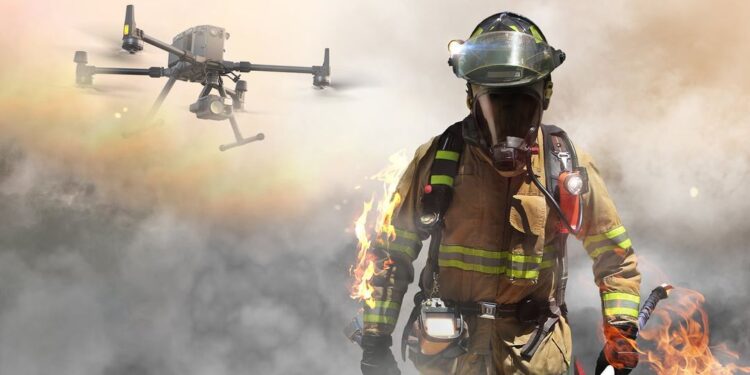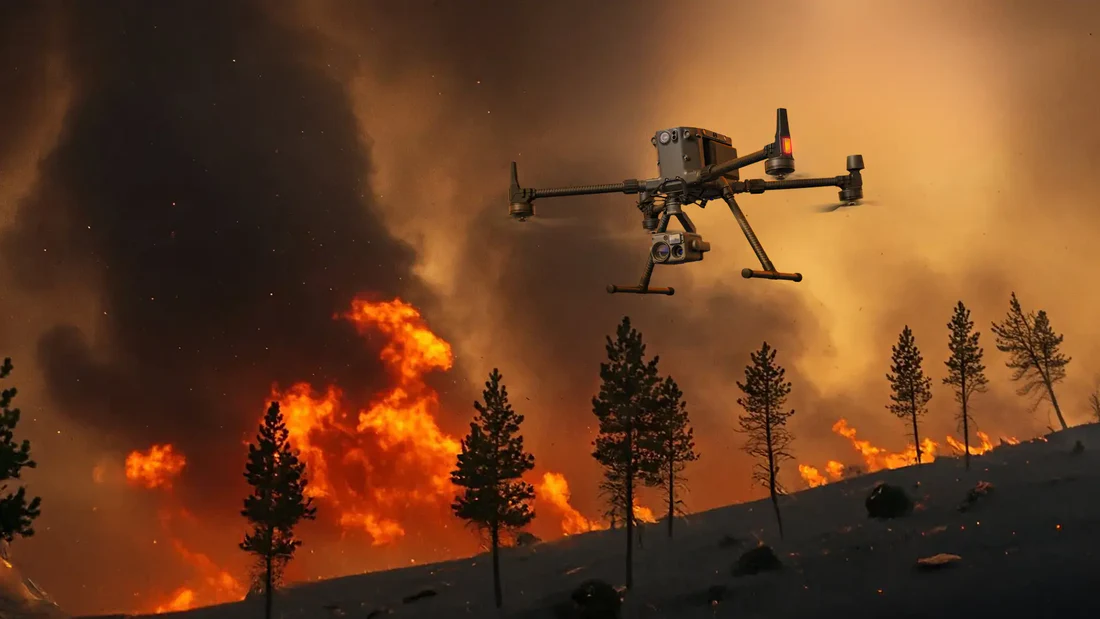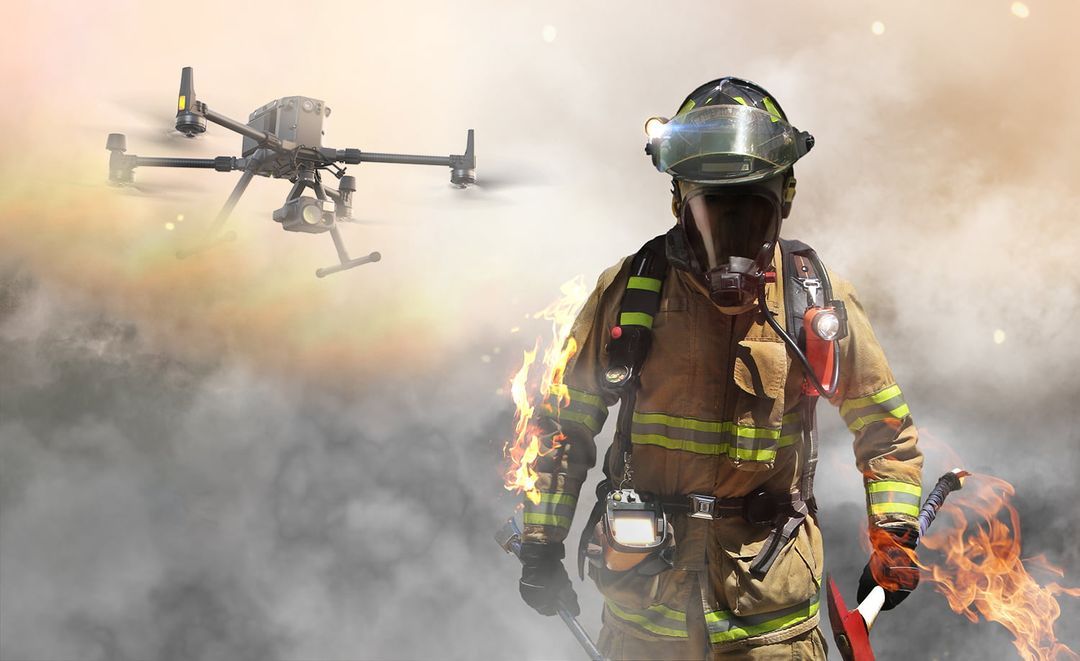Firefighting Drones

Drones have become a vital part of emergency services throughout the United States. More than 900 state and local agencies now use these aerial systems in their operations. The Federal Aviation Administration (FAA) reports that public safety agencies are adopting unmanned aerial vehicles (UAVs) faster than ever. The current fleet of over 10,000 drones will likely grow to more than 30,000 by 2025.
Fire departments need these technological advances to tackle their biggest challenges. The National Fire Protection Association reported 3.7 million fires in 2022 in the United States. These fires caused over 3,700 deaths and $15.5 billion in property damage. On top of that, firefighters faced around 118,070 injuries between 2015 and 2019. Drones offer an affordable way to fight fires while making operations safer and more effective.
The upfront cost of firefighting drones might look steep at around $90,000 for some systems. However, this one-time expense costs less than ongoing helicopter contracts and flight time. These aerial systems can be placed near fire lines and take off quickly. They can reach the fire within minutes. Fire departments looking to upgrade their operations need to understand how these technologies work to make smart choices about using them effectively.

Table of Contents
- 1 How drones are changing firefighting operations
- 2 Key benefits of using drones for fire departments
- 3 Types of firefighting drones and their capabilities
- 4 Challenges and limitations of drone firefighting
- 5 Real-world examples and case studies
- 6 Summing all up
- 7 Here are some FAQs about firefighting drones:
- 7.1 What drones are used in firefighting?
- 7.2 Are Chinese firefighting drones real?
- 7.3 What drones are used in rescue?
- 7.4 What are the four types of drones?
- 7.5 How big is the firefighting drone market?
- 7.6 What are pyro drones?
- 7.7 Are the 8100 drones real in China?
- 7.8 Are exo drones American made?
- 7.9 Are nano drones real?
How drones are changing firefighting operations
Fire departments all over the country now see drones as much more than flying cameras. These unmanned aircraft have changed the way firefighters handle dangerous situations.
Getting a Clear View from Above
Drones now serve as watchful eyes in the sky for fire departments. They give teams a bird’s-eye view that was only possible through costly helicopter flights before. Teams equipped with high-definition cameras send live video feeds of fire scenes. This helps commanders evaluate situations and track how fires spread. The aerial perspective lets teams grasp the full picture of an emergency before anyone arrives at the scene.
The LAFD put this technology to good use during the 2018 Woolsey Fire. Their drones gave firefighters immediate views that helped track the fire’s movement and spot hidden dangers invisible from ground level. Teams can position drones near fire lines and launch them quickly to get vital information when every second counts.
Finding Hidden Heat Sources
The combination of drones and thermal imaging might be the biggest breakthrough in firefighting since the firehose. These specialized cameras pick up heat signatures and let firefighters:
- Spot hidden hotspots inside walls, roofs, or under debris
- Find areas of intense heat that need attention
- Catch potential flare-ups early
- Check buildings in poor visibility
This heat-detecting ability really shines during cleanup operations when teams need to make sure fires are completely out. Forest Service UAS operators use drones like the Anafi parrot with infrared cameras. They spot trouble areas both inside and outside fire boundaries that could reignite if missed.
Finding People in Tough Spots
Drones with thermal cameras become powerful rescue tools when people’s lives hang in the balance. They can quickly scan vast areas and find people’s heat signatures even in smoke, fog, or darkness. A thermal camera drone can do the work of 100 people by covering large areas and finding people who need help.
A recent rescue in the mountains near Santa Barbara proves this point. A search team found a lost hiker after dark using their thermal drone. The rescue took minutes instead of the hours it might have needed without the technology.
Better Decisions with Live Information
Drone data has transformed how commanders direct their teams. They now have solid facts where they once had to guess. This leads to smarter, faster choices in critical moments.
Fire departments can now place their people and equipment more strategically. They respond to changing conditions faster and keep their teams safer. Commanders see exactly how fires move and spread, which helps them adjust their plans on the spot.
Drones do have their limits – short battery life, problems in high winds, and connection issues can cause problems. Yet they’ve become vital tools that make firefighting safer and more effective across the country.

Key benefits of using drones for fire departments
Beyond the tech specs, firefighting drones offer real benefits that affect how fire departments work, keep personnel safe, and get the job done.
Improved firefighter safety
Drones make the job safer by letting teams check dangerous situations from a safe distance. Law enforcement agencies alone reported 79,091 officer assault cases in 2023. This number could be much higher if we count firefighter injuries. Emergency response drones help reduce these numbers. Teams can now spot dangers remotely before sending anyone into risky situations.
Drones with thermal cameras scan collapsed buildings and find survivors. Fire teams can now focus their efforts on specific areas without putting themselves at unnecessary risk. This feature is especially valuable during building collapses, toxic spills, or fires that spread faster.
“Rather than competing with each other, tethered and conventional drones augment each other’s capabilities,” notes one source. Different types of drones work together to make operations safer. The main goal stays the same – keeping firefighters away from life-threatening situations while getting better results.
Faster response and deployment
Drone technology speeds up emergency response times substantially. The Flock Aerodome system cuts response times by 71% on average. It works beyond what the eye can see and covers large areas quickly before ground teams arrive.
Fire teams can now station drones right next to fire lines. This means they can launch and hover over the fire within minutes. Quick deployment helps a lot when fires move fast and conditions change quickly.
Commanders now get instant aerial views that help track fire patterns, spot containment lines, and check risk zones faster. This quick information leads to better decisions at times when every moment matters.
Cost savings over traditional aircraft
Looking at the numbers shows how drones save money compared to regular aircraft:
- One-time cost of about $90,000 for specialized drone systems
- Much cheaper than hiring helicopters and paying for flight time
- Fewer staff needed for aerial watching
- Less reliance on expensive crewed aircraft
A great example happened in 2017. A drone with infrared found a hidden fire spot that nobody could see. Teams put it out quickly, saving $50 million in property and infrastructure. These savings make drones a great choice for departments watching their budgets.
Night and low-visibility operations
Drones can fly when regular aircraft can’t. They work well in smoke, fog, and darkness – conditions that usually keep other aircraft grounded.
Thermal cameras let drones spot heat signatures even when visibility drops to zero. The new H30T Night Scene mode helps teams see better in low light. This means they can keep watching when it’s hardest to see.
Mark Bathrick, former director of DOI’s Office of Aviation Services, points out that drones have “been able to fly in smoky daytime conditions when helicopters or air tankers are grounded, maintaining continuity of operations during poor visibility”. Fire departments can now watch fires from above 24/7 during critical times. No major changes in fire behavior go unnoticed.
Types of firefighting drones and their capabilities
Fire departments across the nation now use specialized unmanned aerial vehicles that match their specific operational needs. These systems showcase how modern firefighting requirements continue to change.
Small drones for surveillance and mapping
Small, agile drones like the Anafi parrot give fire departments crucial surveillance capabilities that reshape the scene of how they gather intelligence. These nimble aircraft deploy faster to capture up-to-the-minute images and video of fire perimeters. Commanders can make quick decisions based on current conditions. First responders can complete aerial surveys within minutes of arrival to map fire boundaries and set response priorities.
These smaller systems stand out with their portability, quick setup times (under 2 minutes), and they work well in wind gusts up to 25 mph. They typically come with regular cameras for visual assessment and specialized equipment for detailed mapping.
Heavy-lift drones for aerial ignition
Heavy-lift drones have changed the game for prescribed burns and backfire operations. The Alta X and Inspired Flight IF1200A platforms with the IGNIS 2 aerial ignition system give firefighters a safer and quicker way to conduct controlled burns. These systems drop standard Dragon Egg ignition spheres into targeted areas with precision to start prescribed fires remotely.
These powerful drones remove the need for personnel to physically enter dangerous areas during ignition operations. Their heavy-lift capability lets some models carry water or fire-extinguishing agents. The HZH XF120 carries four 25kg fire-extinguishing bombs per mission and covers about 200-300 m² each time it deploys.
Tethered drones for continuous monitoring
Tethered drones solve one of the biggest problems with regular UAVs: battery life. Systems like Fotokite Sigma offer constant situational awareness through an active tether that works as both power source and data connection. Firefighters don’t need to land for battery changes, which allows non-stop monitoring during long operations.
Major departments like the Fire Department of New York, Chicago Fire Department, and Los Angeles Fire Department use Fotokite systems. These systems shine especially when departments have limited technical resources or training capacity, thanks to their one-button launch and landing feature.
Thermal drones for heat detection
Experts call thermal-equipped drones “the most revolutionary firefighting aid since the introduction of the firehose”. These specialized aircraft spot heat signatures invisible to the naked eye, which lets firefighters:
- Locate hotspots outside and within fire perimeters
- See through smoke and dense vegetation
- Identify structural weaknesses
- Detect people trapped in low-visibility environments
The Vision Aerial SAR solution combines both visible light and thermal spectrum capabilities in one platform.
AI-enabled drones for fire detection
AI integration with drone technology shows the most promise. AI-powered drones can spot wildfire indicators like smoke plumes and temperature changes before flames become visible. They analyze environmental data including wind speed, topography, and fuel availability to predict how fires might behave.
Brazilian researchers have created drones with sophisticated gas sensors that detect carbon dioxide and methane—the first chemical signs of forest fires—to provide crucial early warnings. These AI-driven systems need fewer human operators while delivering more accurate and timely fire intelligence.
Challenges and limitations of drone firefighting
Firefighting drones have impressive capabilities, but they face several challenges that limit how well they work in certain scenarios. Fire departments need to think over these limitations before adding drones to their operations.
Battery life and flight time constraints
Battery life remains the biggest problem for firefighting drones. Most commercial models run for only 20-30 minutes on a single charge. This makes it hard to monitor situations that take longer to resolve. The problem gets worse when drones carry extra equipment because the added weight uses up more power. Heat from fires can drain batteries faster, which cuts down flight time right when these drones are needed most.
Weather and environmental limitations
Weather affects drone performance by a lot. Strong winds make it hard to keep drones steady and drain batteries faster. Rain or snow can harm the electronics and block camera views. Smoke, fog, and extreme temperatures also make it tough to fly and see clearly. Fire departments need drones with resilient bodies that can handle these challenges, but they still can only fly in certain weather conditions.
Payload and range restrictions
The weight these drones can carry creates another big challenge. Heavier loads use more power and cut flight times. Each drone has a maximum weight limit – going over this can harm the motors and damage equipment. Carrying firefighting tools means balancing between what the drone can do and how long it can stay in the air. Most drones can only lift lightweight equipment, especially when flying high or in hot weather.
Connectivity and data transmission issues
Smooth communication is vital for drone operations. Yet connection problems pop up often, especially during disasters when networks might be down or overloaded. Links between drones and controllers can fail, which stops important information from getting through at critical moments. Remote areas with basic infrastructure face this problem more often, making it hard to use firefighting drones effectively.
Real-world examples and case studies
Innovative drone technology shows remarkable results in emergency situations around the world. These real cases highlight how aerial systems deliver results in different scenarios.
Oak Ridge Fire: Aerial ignition success
The Oak Ridge National Forest saw a breakthrough in March 2022 when teams first used unmanned aerial systems (UAS) to ignite prescribed fires across a research area. This new method matched the effectiveness of traditional ground-ignited prescribed fires from previous years and other stands ignited that same year. The UAS ignition offered clear advantages over helicopter operations. It reduced risk to human safety, cut operating costs, and gave teams more flexibility. This success led the U.S. Forest Service to create a formal UAS program that ensures safe and economical flight missions for natural resource management.
Chongqing wildfire: Thermal drone deployment
Local authorities responded to severe wildfires in Chongqing, China during summer 2022 by sending CW-15 drones with advanced thermal imaging cameras. These aircraft monitored key forest prevention areas at low and medium altitudes. The drones sent video footage back to ground centers instantly, which helped teams analyze data and make quick decisions. A similar operation in Qinghai Province used CW-007 and CW-15 drones to give incident commanders vital topographical data and 3D maps. This helped improve coordination and safety for firefighters on the ground.
Hurricane Idalia: Damage assessment with drones
The Southwest District Emergency Team launched extensive drone surveys after Hurricane Idalia hit as a Category 3 storm in August 2023. The team completed 41 flights and covered 13,000 acres of damaged crops, timber, and structures. These aerial views helped assess areas with heavy destruction, spotted crop losses hidden from ground level, and reached places blocked by fallen power lines and trees. This documentation helped secure disaster aid and gave solid evidence for insurance claims.
Citymesh Belgium: Drone-in-a-box emergency response
Citymesh has changed emergency response in Belgium with its SENSE network of 70 Safety Drones that support police and fire services nationwide. This unique system uses Drone-in-a-Box solutions that deploy within 15 minutes of emergency calls. The drones capture high-definition 4K and thermal images enhanced by AI. This gives teams vital information to speed up and improve emergency responses. Teams have installed about 30 Drones-in-a-Box across Belgian provinces, with 40 more on the way. These drones have already completed over 500 flights for emergency zones.
Summing all up
Firefighting drones have become game-changing tools for emergency services in the United States. These aerial systems give teams vital advantages by improving situational awareness, finding hidden hotspots, helping with search and rescue, and delivering up-to-the-minute data for critical decisions. Fire departments everywhere now see drones as more than flying cameras – they’re essential equipment that saves lives, reduces injuries, and protects property.
Drone technology’s safety benefits speak for themselves. Teams can assess situations remotely, which substantially reduces firefighter exposure to dangerous environments. Thermal imaging helps identify structural weaknesses before personnel enter risky areas. These aircraft deploy quickly and cut response times, letting commanders gather vital information in minutes instead of hours.
The cost factor makes a strong case for drones. While specialized systems might need a $90,000 investment upfront, this one-time expense looks small next to ongoing helicopter costs. Drones work well at night and through smoke conditions that would ground traditional aircraft, extending operations when they’re needed most.
The technology does have its limits. Batteries only last 20-30 minutes, and bad weather can ground these aircraft completely. Payload restrictions and connectivity issues create challenges that fire departments should evaluate before buying.
Available systems range from small surveillance drones to heavy-lift models that can handle aerial ignition, giving departments options based on their needs. Success stories prove their practical value. These unmanned systems have shown their worth in prescribed burns at Oak Ridge National Forest, wildfire monitoring in Chongqing, hurricane damage assessment, and emergency response support in Belgium.
Fire departments today face mounting challenges from population growth, climate change, and limited resources. Drone technology offers a powerful solution that expands capabilities while protecting first responders. Despite some limitations, the future looks clear – unmanned aerial systems will play a bigger role in firefighting operations. Departments that accept new ideas thoughtfully are ready to work better while protecting their teams and communities more effectively.
Here are some FAQs about firefighting drones:
What drones are used in firefighting?
Several specialized firefighting drones are used by emergency services worldwide. These drones for firefighting typically include heavy-lift models capable of carrying fire retardants and thermal imaging drones for hotspot detection. Common models used in drones in firefighting operations are the DJI Matrice series and specially designed industrial drones with fireproof casings.
Are Chinese firefighting drones real?
Yes, Chinese firefighting drones are real and actively used in emergency response operations. The how are drones used in firefighting techniques developed in China include large payload drones that can drop fire suppressants. Several Chinese companies have demonstrated drones firefighting capabilities with models that can carry significant amounts of water or retardant chemicals.
What drones are used in rescue?
Search and rescue operations utilize many of the same drones for firefighting adapted for different scenarios. These drones in firefighting and rescue typically feature thermal cameras, loudspeakers, and sometimes payload delivery systems. The how are drones used in firefighting technology translates well to rescue with added capabilities like life jacket drops or medical supply delivery.
What are the four types of drones?
The four main categories relevant to drones firefighting include multirotor, fixed-wing, single-rotor helicopters, and hybrid VTOL models. For firefighting drones specifically, the classifications focus more on payload capacity, sensor packages, and operational range. Understanding these types helps explain how are drones used in firefighting across different scenarios.
How big is the firefighting drone market?
The global market for drones for firefighting has grown significantly in recent years. Estimates suggest the drones in firefighting sector could reach several hundred million dollars as more departments adopt the technology. The increasing understanding of how are drones used in firefighting contributes to this market expansion across both public and private sectors.
What are pyro drones?
Pyro drones refer to specialized drones firefighting units designed to operate in extreme heat conditions. These drones for firefighting often incorporate heat-resistant materials and cooling systems for electronics. The how are drones used in firefighting with pyro models focuses on direct flame front monitoring and hotspot identification in intense fire environments.
Are the 8100 drones real in China?
Reports of 8100 drones firefighting units being deployed in China appear to be exaggerated claims. While China does have significant drones for firefighting capabilities, the specific 8100 number likely refers to total drones across multiple agencies rather than a single operation. The actual drones in firefighting deployments are substantial but more modest in scale.
Are exo drones American made?
Some exoskeleton-equipped drones firefighting systems are developed by American companies. These drones for firefighting with exo-structures are designed for enhanced durability in harsh conditions. However, the drones in firefighting sector includes international collaboration, with similar technologies being developed worldwide.
Are nano drones real?
Yes, nano drones are real and represent the smallest category of drones for firefighting and surveillance. While too small for direct fire suppression, these drones in firefighting operations serve as reconnaissance tools in confined spaces. The how are drones used in firefighting with nano models focuses on situational awareness and interior structure assessment.

